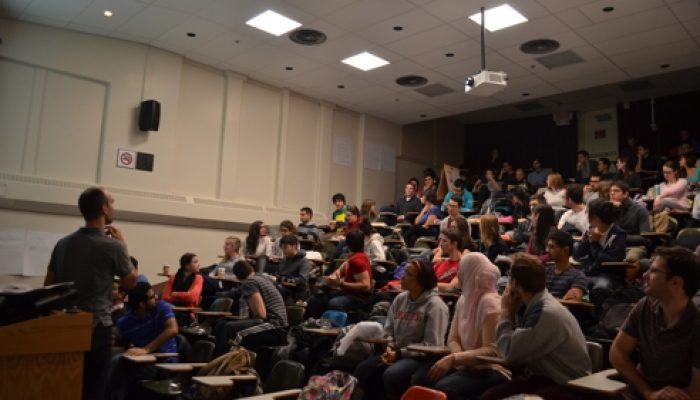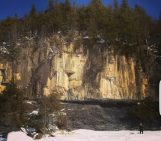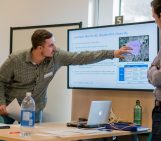
Active learning in large classrooms is difficult but not impossible – here is one example of an active learning technique developed for small classrooms, the gallery walk, which I have successfully re-purposed for a class of 100 (but I see no real upper limit on class size with the modified version of this activity).
“In Gallery Walk student teams rotate to provide bulleted answers to questions posted on charts arranged around the classroom. After three to five minutes at a chart or ‘station’ the team rotates to the next question. Gallery Walk works best with open ended questions, that is, when a problem, concept, issue, or debate can be analyzed from several different perspectives.” SERC Pedagogy in action

Teaching a large class. Photo by Maria Orjuela-Laverde, courtesy of Faculty of Engineering, McGill University
In most large classes in auditoriums, there is not the time or space for students to actually walk around the ‘gallery’. So instead I bring the ‘gallery’ of four provocative questions to groups of students on clipboards that are rotated around the classroom :
- the class is split into four quadrants which are further divided into four groups (so ~5 people per group for a class of 100). Each group starts with a clipboard with one of the four questions and the four groups in the each quadrant should have the four different questions (good to check before starting).
- Students are given 5-10 minutes to respond to the question on their clipboards and then clipboards are rotated until each group has answered each question. Students can constructively respond to previous groups answers to the same question.
- After four rotations each group should have the question they started with and I ask a few groups to report out a summary to class which I synthesize on the board. In my case we end the activity with a vote of the ‘world’s biggest water problem’.
I find this an excellent way to start and/or end a term. In my case I teach a rather technical undergraduate engineering class about hydrology and water resources – this is an excellent tool to encourage students to think very broadly and creatively about the topic before and/or after we learn technical details.
This activity was inspired by conversations at the ‘Cutting Edge’ Early Career Geoscientist workshop in June 2012 College of William and Mary, Williamsburg, VA. The workshop is sponsored by the National Association of Geoscience Teachers (NAGT) with funding provided by the National Science Foundation Division of Undergraduate Education. I thank the workshop leaders, NAGT and NSF for this opportunity and encourage other early career geoscientists to check out future workshops.





Pingback: Active learning in large classes: a gallery ‘walk’ with a 100 students | Teaching for Learning @ McGill University
mattcurrell
Sounds great. Something else that works well is a ‘unjumble the terms’ excercise along similar lines. Give students 3 sets of different coloured slips of paper, one corresponding to a) a technical term (e.g., hydraulic conductivity) b) a definition; c) symbol and units. Then ask students to arrange the right combinations of all 3, for 15 or so key terms used in hydrogeology.
Because there is so much language that is discipline specific, and which we instructors take for granted, it’s important to get students up to speed with the ‘language of hydrogeology’. This exercise, introduced 1-2 months after beginning a hydrogeology course, I have found to be really effective.